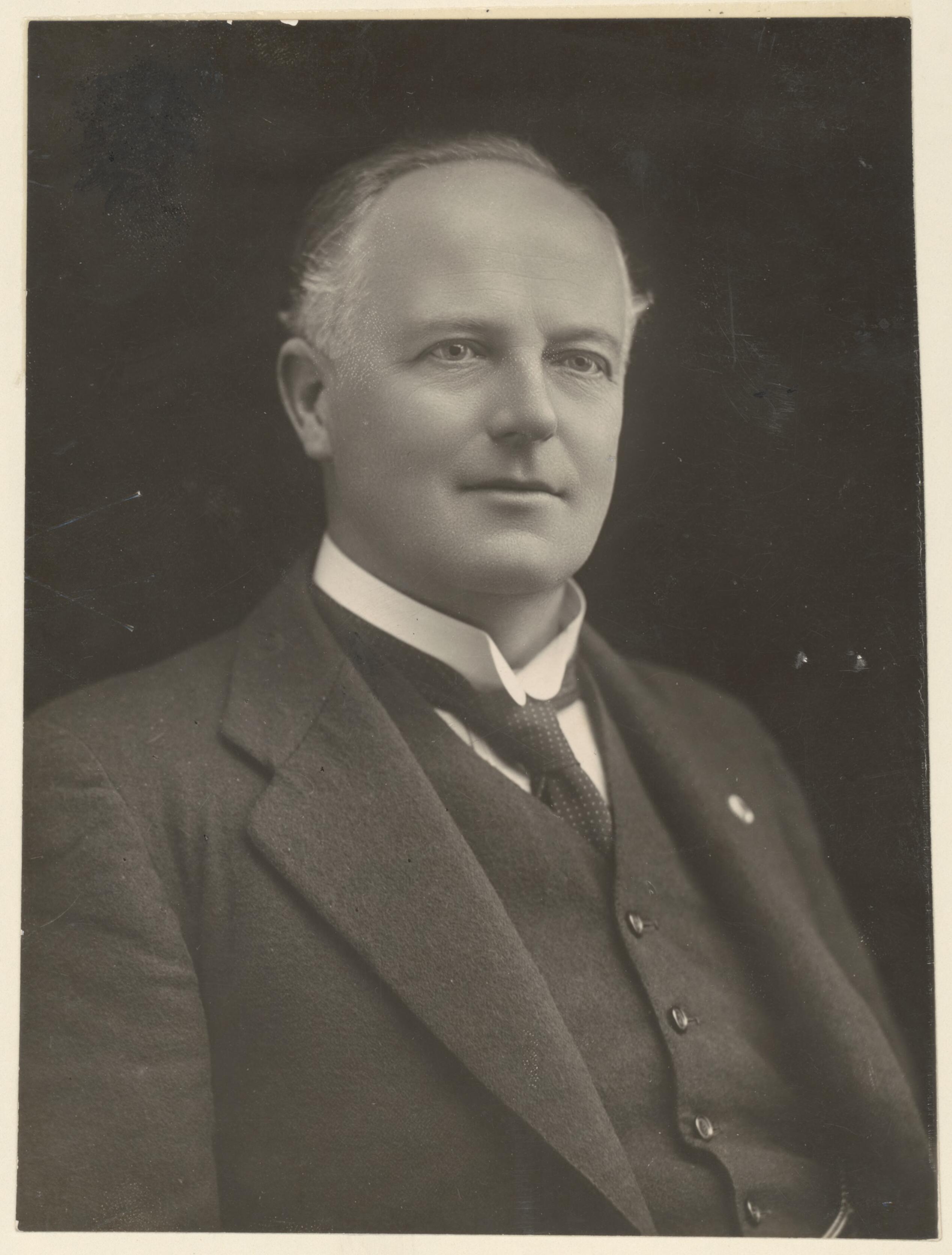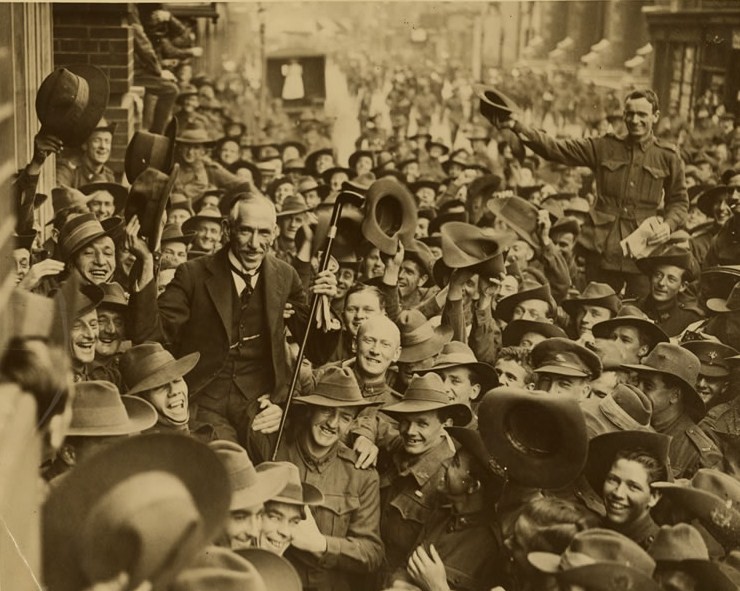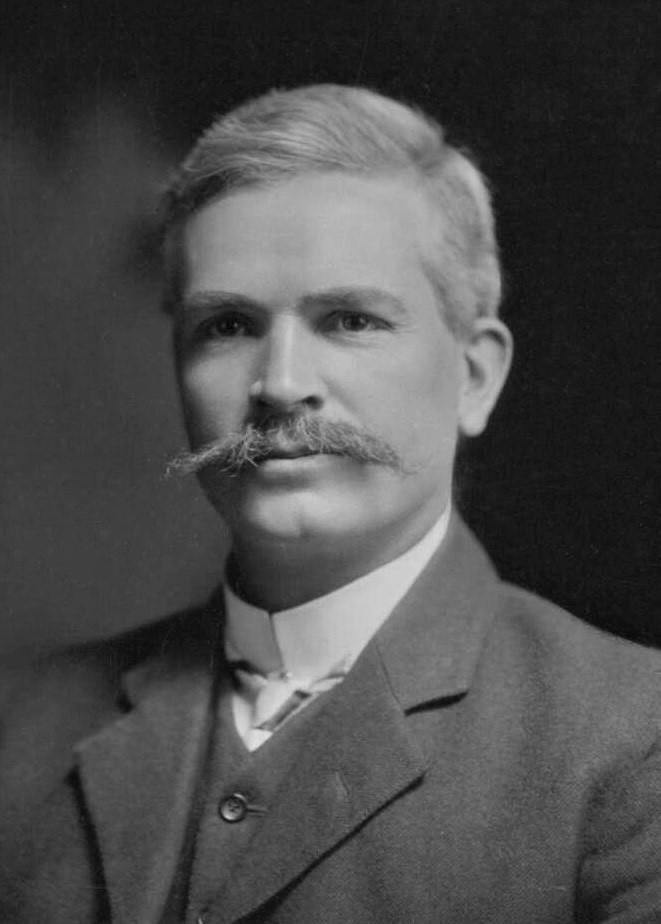|
Eric Bowden
Eric Kendall Bowden (30 September 1871 – 13 February 1931) was an Australian politician. A solicitor by profession, he served as Minister for Defence from 1923 to 1925, under Prime Minister Stanley Bruce. He was a member of the House of Representatives from 1906 to 1910 and 1919 to 1929. Early life Bowden was born in Parramatta, New South Wales, the second son of Sarah Anne (née Smith) and John Ebenezer Bowden. His great-grandfather Thomas Bowden had arrived in the colony in 1812 and became one of Parramatta's earliest schoolmasters. Educated at Newington College (1882-1884) and Sydney Boys High School (1888–92), Bowden qualified as a solicitor in 1894 after serving articles with his father. Four years he later married Reinetta May Murphy. In 1902, he took possession of Endrim, a former clergy house previously owned by his father. It is now heritage listed. Political career Bowden was an alderman on the Granville Borough Council from 1904 to 1907. He was elected to ... [...More Info...] [...Related Items...] OR: [Wikipedia] [Google] [Baidu] |
The Honourable
''The Honourable'' (British English) or ''The Honorable'' (American English; see spelling differences) (abbreviation: ''Hon.'', ''Hon'ble'', or variations) is an honorific style that is used as a prefix before the names or titles of certain people, usually with official governmental or diplomatic positions. Use by governments International diplomacy In international diplomatic relations, representatives of foreign states are often styled as ''The Honourable''. Deputy chiefs of mission, , consuls-general and consuls are always given the style. All heads of consular posts, whether they are honorary or career postholders, are accorded the style according to the State Department of the United States. However, the style ''Excellency'' instead of ''The Honourable'' is used for ambassadors and high commissioners. Africa The Congo In the Democratic Republic of the Congo, the prefix 'Honourable' or 'Hon.' is used for members of both chambers of the Parliament of the Democratic Repu ... [...More Info...] [...Related Items...] OR: [Wikipedia] [Google] [Baidu] |
Australian House Of Representatives
The House of Representatives is the lower house of the bicameral Parliament of Australia, the upper house being the Senate. Its composition and powers are established in Chapter I of the Constitution of Australia. The term of members of the House of Representatives is a maximum of three years from the date of the first sitting of the House, but on only one occasion since Federation has the maximum term been reached. The House is almost always dissolved earlier, usually alone but sometimes in a double dissolution of both Houses. Elections for members of the House of Representatives are often held in conjunction with those for the Senate. A member of the House may be referred to as a "Member of Parliament" ("MP" or "Member"), while a member of the Senate is usually referred to as a "Senator". The government of the day and by extension the Prime Minister must achieve and maintain the confidence of this House in order to gain and remain in power. The House of Representatives c ... [...More Info...] [...Related Items...] OR: [Wikipedia] [Google] [Baidu] |
Eric Kendall Bowden
The given name Eric, Erich, Erikk, Erik, Erick, or Eirik is derived from the Old Norse name ''Eiríkr'' (or ''Eríkr'' in Old East Norse due to monophthongization). The first element, ''ei-'' may be derived from the older Proto-Norse ''* aina(z)'', meaning "one, alone, unique", ''as in the form'' ''Æ∆inrikr'' explicitly, but it could also be from ''* aiwa(z)'' "everlasting, eternity", as in the Gothic form ''Euric''. The second element ''- ríkr'' stems either from Proto-Germanic ''* ríks'' "king, ruler" (cf. Gothic ''reiks'') or the therefrom derived ''* ríkijaz'' "kingly, powerful, rich, prince"; from the common Proto-Indo-European root * h₃rḗǵs. The name is thus usually taken to mean "sole ruler, autocrat" or "eternal ruler, ever powerful". ''Eric'' used in the sense of a proper noun meaning "one ruler" may be the origin of ''Eriksgata'', and if so it would have meant "one ruler's journey". The tour was the medieval Swedish king's journey, when newly elected, to s ... [...More Info...] [...Related Items...] OR: [Wikipedia] [Google] [Baidu] |
1922 Australian Federal Election
The 1922 Australian federal election was held in Australia on 16 December 1922. All 75 seats in the House of Representatives, and 19 of the 36 seats in the Senate were up for election. The incumbent Nationalist Party, led by Prime Minister Billy Hughes lost its majority. However, the opposition Labor Party led by Matthew Charlton did not take office as the Nationalists sought a coalition with the fledgling Country Party led by Earle Page. The Country Party made Hughes's resignation the price for joining, and Hughes was replaced as Nationalist leader by Stanley Bruce. Future Prime Minister Frank Forde and future opposition leader John Latham both entered parliament at this election. At this election, Hughes as the sitting prime minister made his second seat transfer, in this case, from Bendigo to North Sydney. Hughes had held Bendigo since transferring there from West Sydney at the 1917 election also as the sitting prime minister. Hughes remains the only sitting Prime Ministe ... [...More Info...] [...Related Items...] OR: [Wikipedia] [Google] [Baidu] |
Nationalist Party (Australia)
The Nationalist Party, also known as the National Party, was an Australian political party. It was formed on 17 February 1917 from a merger between the Commonwealth Liberal Party and the National Labor Party, the latter formed by Prime Minister Billy Hughes and his supporters after the 1916 Labor Party split over World War I conscription. The Nationalist Party was in government (from 1923 in coalition with the Country Party) until electoral defeat in 1929. From that time it was the main opposition to the Labor Party until it merged with pro-Joseph Lyons Labor defectors to form the United Australia Party (UAP) in 1931. The party is a direct ancestor of the Liberal Party of Australia, the main centre-right party in Australia. History In October 1915 the Australian Prime Minister, Andrew Fisher of the Australian Labor Party, retired; Billy Hughes was chosen unanimously by the Labor caucus to succeed him. Hughes was a strong supporter of Australia's participation in World War ... [...More Info...] [...Related Items...] OR: [Wikipedia] [Google] [Baidu] |
1919 Australian Federal Election
The 1919 Australian federal election was held on 13 December 1919 to elect members to the Parliament of Australia. All 75 seats in the House of Representatives and 19 of the 36 seats in the Senate were up for election. The incumbent Nationalist Party government won re-election, with Prime Minister Billy Hughes continuing in office. The 1919 election was the first held since the passage of the ''Commonwealth Electoral Act 1918'', which introduced preferential voting for both houses of parliament – instant-runoff voting for the House of Representatives and preferential block voting for the Senate. It was held several months earlier than constitutionally required, so that the government could capitalise on the popularity of Hughes after his return from the Paris Peace Conference. The Nationalists campaigned on the government's war record and appealed to return soldiers. The Australian Labor Party (ALP), in opposition since the 1916 party split, contested a second election under ... [...More Info...] [...Related Items...] OR: [Wikipedia] [Google] [Baidu] |
Australian Labor Party
The Australian Labor Party (ALP), also simply known as Labor, is the major centre-left political party in Australia, one of two major parties in Australian politics, along with the centre-right Liberal Party of Australia. The party forms the federal government since being elected in the 2022 election. The ALP is a federal party, with political branches in each state and territory. They are currently in government in Victoria, Queensland, Western Australia, South Australia, the Australian Capital Territory, and the Northern Territory. They are currently in opposition in New South Wales and Tasmania. It is the oldest political party in Australia, being established on 8 May 1901 at Parliament House, Melbourne, the meeting place of the first federal Parliament. The ALP was not founded as a federal party until after the first sitting of the Australian parliament in 1901. It is regarded as descended from labour parties founded in the various Australian colonies by the emerging la ... [...More Info...] [...Related Items...] OR: [Wikipedia] [Google] [Baidu] |
1910 Australian Federal Election
The 1910 Australian federal election was held in Australia on 13 April 1910. All 75 seats in the House of Representatives, and 18 of the 36 seats in the Senate were up for election. The incumbent Commonwealth Liberal Party (the result of a merger between the Protectionist Party and the Anti-Socialist Party) led by Prime Minister Alfred Deakin was defeated by the opposition Labour Party, led by Andrew Fisher. The election represented a number of landmarks: it was Australia's first elected federal majority government; Australia's first elected Senate majority; the world's first Labour party majority government at a national level; after the 1904 Chris Watson minority and Fisher's former minority government the world's third Labour party government at a national level; the first time it controlled ''both'' houses of a bicameral legislature; and the first time that a prime minister, in this case Deakin, was defeated at an election. It also remains the only election in Australia's ... [...More Info...] [...Related Items...] OR: [Wikipedia] [Google] [Baidu] |
1906 Australian Federal Election
The 1906 Australian federal election was held in Australia on 12 December 1906. All 75 seats in the House of Representatives, and 18 of the 36 seats in the Senate were up for election. The incumbent Protectionist Party minority government led by Prime Minister Alfred Deakin retained government, despite winning the fewest House of Representatives votes and seats of the three parties. Parliamentary support was provided by the Labour Party led by Chris Watson, while the Anti-Socialist Party (renamed from the Free Trade Party), led by George Reid, remained in opposition. Watson resigned as Labour leader in October 1907 and was replaced by Andrew Fisher. The Protectionist minority government fell in November 1908 to Labour, and a few days later Reid resigned as Anti-Socialist leader, being replaced by Joseph Cook. The Labour minority government fell in June 1909 to the newly formed Commonwealth Liberal Party led by Deakin; this Party was formed on a shared anti-Labour platform as a ... [...More Info...] [...Related Items...] OR: [Wikipedia] [Google] [Baidu] |
Municipality Of Granville
The Municipality of Granville was a local government area in the Western region of Sydney, New South Wales, Australia. The municipality was proclaimed as the Borough of Granville on 20 January 1885. It included the modern suburbs of Granville, South Granville, Camellia, Rosehill, Clyde and parts of Harris Park, Guildford and Merrylands. From 1 January 1949, the council was amalgamated into the City of Parramatta, with the passing of the '' Local Government (Areas) Act 1948''. Council history Early years and development The area was first incorporated on 20 January 1885, when the Governor of New South Wales, Lord Augustus Loftus, proclaimed the "Borough of Granville". Alban Gee was appointed the first returning officer for the council election on 18 March 1885, with nine aldermen elected at-large. The prominent conveyancer and local landowner behind Granville's incorporation, John Nobbs, was elected the first mayor, and John Southwood Beach was appointed first Town Cler ... [...More Info...] [...Related Items...] OR: [Wikipedia] [Google] [Baidu] |
Clergy House
A clergy house is the residence, or former residence, of one or more priests or ministers of religion. Residences of this type can have a variety of names, such as manse, parsonage, rectory or vicarage. Function A clergy house is typically owned and maintained by a church, as a benefit to its clergy. This practice exists in many denominations because of the tendency of clergy to be transferred from one church to another at relatively frequent intervals. Also, in smaller communities, suitable housing is not as available. In addition, such a residence can be supplied in lieu of salary, which may not be able to be provided (especially at smaller congregations). Catholic clergy houses in particular may be lived in by several priests from a parish. Clergy houses frequently serve as the administrative office of the local parish, as well as a residence. They are normally located next to, or at least close to, the church their occupant serves. Partly because of the general conservati ... [...More Info...] [...Related Items...] OR: [Wikipedia] [Google] [Baidu] |
Endrim
Endrim is a heritage-listed former residence and clergy house and now offices at 54 Sorrell Street, Parramatta, Sydney, New South Wales, Australia. It was designed by James Houison and built from 1854 to 1856 by James Houison and Nathaniel Payton. It was added to the New South Wales State Heritage Register on 2 April 1999. History The site on which Endrim would be built is in Section 40 of the Town of Parramatta, which had been subdivided into regular allotments by this time and was formally proclaimed in 1893. Most of the block, an area of over two areas was officially granted to Reverend William F. Gore in November 1853. Gore had arrived in the colony in 1841 with his widowed mother and two elder brothers who became pastoralists in Queensland. William followed in the footsteps of his father who was a Protestant Irish clergyman. William completed his studies in Sydney and was ordained as an Anglican clergyman in 1844. He married in the same year and was appointed rector o ... [...More Info...] [...Related Items...] OR: [Wikipedia] [Google] [Baidu] |


.jpg)



